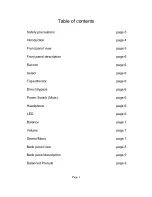
Page
6
Front panel description
RECORD
- Controls which one of the six input pairs is routed directly to the record output
connectors (REC OUT). The selected input signal bypasses the remainder of
the preamplifier’s circuitry to provide the purest possible recording source.
SELECT
-
Controls which one of the six input pairs is routed to the processing circuitry
and then to the preamplifier output connectors (PRE AMP OUT). The signal
made available at these connectors is used to drive the external power
amplifiers.
TAPE
MONITOR
- The tape monitor switch allows the tape deck connected to the tape monitor
inputs (TMON IN) to be routed to the processing circuitry and then to the
preamplifier’s output connectors (PRE AMP OUT) independent of the position
of SELECT. The input signal selected via SELECT remains valid but is
overridden while the TAPE MONITOR switch is in the ON position (switch
pushed in). Turning the TAPE MONITOR off (switch pushed out) restores the
input signal determined by the SELECT position.
DIRECT
BYPASS
-
The DIRECT BYPASS switch selects the active or passive mode. In the active
mode (switch out) the selected signal is processed through a 20 dB DC
coupled amplifier. The passive mode (switch in) bypasses the gain stage of
the preamplifier.
POWER
SWITCH
-
The power switch is actually a mute switch. This switch changes the mode of
the preamplifier. With the switch on, LED illuminated, the signal is passed
from the source to the amplifier. With the switch off, LED off, the source is
passed to the headphone jack.
HEAD-
PHONE
-
Stereo headphones having a standard ¼ inch binaural plug can be connected
to the headphone output. The mute switch must be in the off position for the
headphone output to be enabled.
LED
-
Indicates which mode the preamplifier is in. When the LED is illuminated the
preamplifier passes the selected source to the outputs of the preamplifier to
the amplifiers. When the LED is off the preamplifier passes the selected
source to the headphone jack.


















